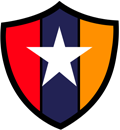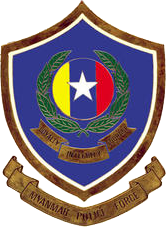Myanmar Police Force
Law enforcement agency From Wikipedia, the free encyclopedia
The Myanmar Police Force (Burmese: မြန်မာနိုင်ငံ ရဲတပ်ဖွဲ့), formerly the People's Police Force (ပြည်သူ့ ရဲတပ်ဖွဲ့), is the law enforcement agency of Myanmar. It was established in 1964 as an independent department under the Ministry of Home Affairs.
This article needs additional citations for verification. (June 2020) |
| Myanmar Police Force မြန်မာနိုင်ငံ ရဲတပ်ဖွဲ့ | |
|---|---|
 Coat of arms | |
 Emblem | |
 Flag | |
| Motto | "ကူညီပါရစေ" (May I help you.) |
| Agency overview | |
| Formed | 1964 |
| Preceding agency | |
| Employees | 93,000 (2012)[1] |
| Jurisdictional structure | |
| Operations jurisdiction | Myanmar |
| Legal jurisdiction | Myanmar |
| General nature | |
| Operational structure | |
| Headquarters | Naypyidaw |
| Elected officer responsible |
|
| Agency executive |
|
| Parent agency | Ministry of Home Affairs |
| Child agencies |
|
| Website | |
| Official website | |
History
Summarize
Perspective
The Police Force in Myanmar have an extensive history; the police force also includes local police and regional police in different jurisdictions.
British rule in Myanmar
The primary police force in British Burma was the Burma Police. In addition, there was a paramilitary Burma Military Police, the Railway Police, and the Rangoon Town Police. From roughly 1891, most executive positions within the Burma Police were filled by members of the Indian Imperial Police cadre.
In 1872 the third mayor of Mergui District, Sir Ashly Din (1870–1875) assigned the first police officer to be stationed at Maliwan, a village 24 miles north of current Victoria Point.
Perhaps the most famous policeman in Burma from this period is the author George Orwell, who in 1922 joined the Indian Imperial Police in Burma. Another famous colonial policeman in Burma was Hector Hugh Munro, known as Saki.
Post-independence (1948–present)

On 16 March 1988 following the killing of two students during the pro-democracy demonstrations, students marching on Prome Road were confronted near Inya Lake by the security force riot police and many beaten to death or drowned.
Despite controversies and corruption accusations, the Burmese police and the Home Affairs Ministry play an important role in the country, solving numerous crimes.

The national police are made up of several smaller entities, including
- Myanmar Railways Police
- Intelligence division
Organisation
Summarize
Perspective
The current Director General of Myanmar Police Force is Major General Zin Min Htet with its headquarters in Naypyidaw. Its command structure is based on established civil jurisdictions. Under the command of police headquarters, state and region police forces have been established in respective territories of states and divisions with headquarters in their capital cities.[3]
State and division police forces
There are 14 state and divisional police forces and three additional state/division police forces commanded by police brigadiers or colonels. Their jurisdictions are divided according to the Civil Administration. The states and divisions, additional states have the same status.
Each state and divisional police force consist of four components.
- Office of the Commander of the State and Divisional Police Force
- Office of the Commander of the District Police Force
- Office of the Commander of the Township Police Force
- Police Stations
In previous time, the district police forces are classified into two classes depending on the area, population and development, namely A and B Class. Commanders of the A Class District Police Forces are police lieutenant colonels, and B Classes are police majors, but there is no classification and all districts assigned with lieutenant colonel. Commanders of township police forces are police majors, and police station officers are police captains.
Special Departments
There are four Special Departments, in which the first ten departments are headed by the police brigadier generals and the remaining two are by police colonels.
- Security Police Force
- Border Guard Police Force
- Special Intelligence Department (Special Branch)
- Criminal Investigation Department (CID)
- Railways Police Department
- Anti-human Trafficking Police Force
- Maritime Police force
- Aviation Police Force
- Drug Enforcement Division
- Financial Investigation force
- Myanmar Traffic Police
- Tourist Security Police Force
- Oil Field Security Police Force
- Forestry Security Police Force
- Highway Police Force
- Municipal Police Department
Training Centres
There are three main Training Centers, one Central Training Institute of Myanmar Police Force and Three Police Training Depots. The State and Divisional Police Forces have their own training centres for refresher courses and Junior Leader (NCO) Courses.
Bachelor's degree holders from Distance Learning University were disqualified from sitting the SIP exam. Thus vast numbers of Bachelor holding police personal were concerned for their future.
| Course Name | Duration |
|---|---|
| Deputy Superintendent Cadet Course | 50 weeks |
| Sub-Inspector Cadet Course | 6 weeks |
| Surveillance Officer Course | 6 weeks |
| Investigation Officer Course | 6 weeks |
| Police Station Officer Course | 8 weeks |
| Staff Officer Course | 6 weeks |
| Township Police Commander Course | 8 weeks |
| District Police Commander Course | 12 weeks |
No. 1 Police Training Depot
The No.1 Police Training Depot is commanded by a Police Lieutenant Colonel and undertakes:
| Course Name | Duration |
|---|---|
| Basic Training Course for Lance Corporal and Corporal | 4 weeks |
| Warrant Officer and Police Sergeants Course | 12 Weeks |
| Basic Training Course for Constables | 24 weeks |
| Clerical Training | 4 weeks |
| Instructor Renewal Course | 4 weeks |
No. 2 Police Training Depot
The No.2 Police Training Depot is also commanded by a Police Lieutenant Colonel, and undertakes only Basic Training Course for Constables, which normally takes around 6 months to complete.
| Course Name | Duration |
|---|---|
| Basic Training Course for Constables | 6 Months |
Taung Lay Lone Police Training Depot
The Taung Lay Lone Police Training Depot is commanded by a Police Lieutenant Colonel and undertakes:
| Course Name | Duration |
|---|---|
| Basic Training Course for lance corporal and Corporal | 4 weeks |
| Warrant Officer and Police Sergeants Course | 12 Weeks |
| Basic Training Course for Constables | 6 Months |
Combat Police Battalions (SWAT)
There are sixteen Police Battalions to carry out general security duties under the command of Battalion Control Command. The Battalion Commandants are Police Lieutenant Colonels. As the populace of the cities including Yangon and Mandalay have been increased day after day, problems on social, economy and politics are risen up that could lead to emergence of civil unrest and sabotage. It is necessary to prevent from destruction and harassment, VIP and project factories and workshops, security of diplomats and their embassies. Seven of these Police Battalions are situated in the Yangon Divisional areas and two in Mandalay and three in Arakan, one in Sagaing, one in Mon State, one in Pegu, one in Prome.
These specially-trained and combat capable battalions are formed with personnel from former Riot Security Police, better known as "Lon Htein" Units. Each battalion consists of 500+ personnel and these battalions are supported by two support battalions, which include signal and medical units. These battalions structure are similar to that of Army's Light Infantry Battalions and they are subordinate to their respective Regional Military Commands.[1]
- 1st Combat Police Battalion (HQ at Hlawga)
- 2nd Combat Police Battalion (HQ at Maungtaw)
- 3rd Combat Police Battalion (HQ at Shwemyayar)
- 4th Combat Police Battalion (HQ at Shwesaryan)
- 5th Combat Police Battalion (HQ at Hmawbi)
- 6th Combat Police Battalion (HQ at Shwepyitha)
- 7th Combat Police Battalion (HQ at Kyauktan)
- 8th Combat Police Battalion (HQ at Mingaladon)
- 9th Combat Police Battalion (HQ at Hlaingthaya)
- 10th Combat Police Battalion (HQ at Pyay/Prome)
- 11th Combat Police Battalion
- 12th Combat Police Battalion
- 14th Combat Police Battalion (HQ at Pa Lake, Mandalay)
- 15th Combat Police Battalion
- 16th Combat Police Battalion
Anti-Narcotic Task Forces
26 special anti-narcotic task forces have been established under the direction of the Central Committee for Drug Abuse Control.
Equipment
Summarize
Perspective
Small arms
Myanmar Police Force uses a wide range of weapons and ammunitions, ranging from Second World War vintage weapons to modern sophisticated ones.
Most of the weapons are either seized from ethnic militias and criminals or are locally-produced copies of the G3 and other weapons phased out by the army.
Non-Lethal Weapons
Automobiles
Cars and Trucks
- Chevrolet Suburban (confiscated item),
- Range Rover donated by Foreign Organisations for Anti-drugs Enforcement,
- Mercedes Benz C-Class sedan (confiscated item),
- Toyota Dyna paddy wagon (Private-owned vehicles are commonly called volunteer patrol cars),
- Toyota closed double cab (confiscated item, used by escort team, patrol),
- Mitsubishi double cab (confiscated item, used by Police Col, Yangon),
- Mitsubishi pickup (confiscated item, used by Township Police Station, Yangon),
- Mitsubishi pickup (confiscated item, used by Police Lt Col, Yangon),
- Toyota pickup (confiscated item, used by Township Police Station, Yangon),
- FAW pickup,
- Honda Saloon, Patrol car,
- Jeep, Used by police station,
- Mazda B pick-up, Used by police station,
- Toyota Celica, used as a police lead vehicle and as a high-speed police car to arrest sport cars,
- Nissan Fairlady Z, used as a police lead vehicle and as a high-speed police car to arrest sport cars.
Armoured vehicles
| Photo | Model | Type | Quantity | Origin | Notes | ||
|---|---|---|---|---|---|---|---|
| Armoured vehicle/Armoured personnel carrier | |||||||
| ZFB-05 | Armoured personnel carrier | 10[6] | Received by 2011, they were transferred to police from Myanmar Army.[6] | ||||
| Sinotruk HOWO | Water cannon truck | unknown | One of the most widely used against protesters in February 2021 Myanmar. | ||||
| BAAC-87 | Armoured personnel carrier | unknown | One of the most widely used against protesters in February 2021 Myanmar. | ||||
Coastal Patrol Craft
| Class | Builder | Serial Number | Year Entered Service | Armament | Note |
|---|---|---|---|---|---|
| PGM class | 331 332 333 334 | 2012 | machine guns | ||
River Patrol Boat
Rank structure and insignia
Commissioned officers
| Rank group | General / flag officers | Senior officers | Junior officers | |||||||||||||||||||||||||||||||||||
|---|---|---|---|---|---|---|---|---|---|---|---|---|---|---|---|---|---|---|---|---|---|---|---|---|---|---|---|---|---|---|---|---|---|---|---|---|---|---|
 |
 |
 |
 |
 |
 |
 |
 |
 |
 |
 |
||||||||||||||||||||||||||||
| ရဲဗိုလ်ချုပ်ကြီး raaibauilaʻ khayupaʻ krīʺ |
ဒုတိယရဲဗိုလ်ချုပ်ကြီး dautaiya raaibauilaʻ khayupaʻ krīʺ |
ရဲဗိုလ်ချုပ် raaibauilaʻ khayupaʻ |
ရဲမှူးချုပ် raaimahūʺ khayupaʻ |
ရဲမှူးကြီး raaimahūʺ karī |
ဒုတိယရဲမှူးကြီး dautaiya raaimahūʺ karī |
ရဲမှူး raaimahūʺ |
ဒုတိယရဲမှူး dautaiya raaimahūʺ |
ရဲအုပ် raai ’aupaʻ |
ဒုတိယရဲအုပ် dautaiya raai ’aupaʻ |
ဒုတိယရဲအုပ်လောင်း dautaiya raai ’aupaʻ laoṅaʻʺ | ||||||||||||||||||||||||||||
Enlisted ranks
| Rank group | Senior NCOs | Junior NCOs | Enlisted | |||||||||||||||||||||||||||||||||
|---|---|---|---|---|---|---|---|---|---|---|---|---|---|---|---|---|---|---|---|---|---|---|---|---|---|---|---|---|---|---|---|---|---|---|---|---|
 |
No insignia | No insignia | ||||||||||||||||||||||||||||||||||
| ရဲအရာခံဗိုလ် Raai ’araā khaṃ bauilaʻ |
ရဲတပ်ကြပ်ကြီး Raai tapaʻ karpaʻ krīʺ |
ရဲတပ်ကြပ် Raai tapaʻ karpaʻ |
ဒုတိယရဲတပ်ကြပ် Dautaiya tapaʻ karpaʻ |
ရဲတပ်သား Raai tapaʻ saāʺ |
ရဲတပ်သားသစ် Raai tapaʻ saāʺ sacaʻ | |||||||||||||||||||||||||||||||
See also
References
Wikiwand - on
Seamless Wikipedia browsing. On steroids.
